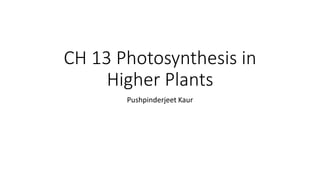
Ch 13 photosynthesis in higher plants xi (1)
- 1. CH 13 Photosynthesis in Higher Plants Pushpinderjeet Kaur
- 2. HISTORICAL BACKGROUND • Photosynthesis is important due to two reasons: • it is the primary source of all food on earth. • It is also responsible for the release of oxygen into the atmosphere by green plants.
- 3. Joseph Priestley • Joseph Priestley (1733-1804) in 1770 performed a series of experiments that revealed the • essential role of air in the growth of green plants. • Priestley discovered oxygen in 1774.
- 4. Jan Ingenhousz • Jan Ingenhousz (1730-1799) • showed that sunlight is essential to the plant process an aquatic plant showed that in bright sunlight, small bubbles were formed around the green parts while in the dark they did not. • Later he identified these bubbles to be of oxygen. Hence he showed that it is only the green part of the plants that could release oxygen.
- 5. T.W Engelmann • In 1854 Julius von Sachs provided evidence for production of glucose when plants grow. • T.W Engelmann (1843 – 1909). Using a prism he split light into its spectral components and then illuminated a green alga, Cladophora, placed in a suspension of aerobic bacteria. • The bacteria were used to detect the sites of O2 evolution. • He observed that the bacteria accumulated mainly in the region of blue and red light of the split spectrum. A first action spectrum of photosynthesis was thus described. It resembles roughly the absorption spectra of chlorophyll a and b.
- 6. • Cornelius van Niel (1897-1985), who, based on his studies of purple and green bacteria, demonstrated that photosynthesis is essentially a light-dependent reaction in which hydrogen from a suitable oxidisable compound reduces carbon dioxide to carbohydrates. • WHAT IS THE SITE OF PHOTOSYNTHESIS??
- 8. CHLOROPLAST • Double membranous structure • Outer and inner membrane • Site of dark reaction – stroma • Site of light reaction - thylakoid
- 9. PAPER CHROMATOGRAPHY four pigments: • Chlorophyll a (bright or blue green in the chromatogram), • chlorophyll b (yellow green), • xanthophylls (yellow) and • carotenoids (yellow to yellow-orange).
- 11. CONCLUSION • most of the photosynthesis takes place in the blue and red regions of the spectrum; • some photosynthesis does take place at the other wavelengths of the visible spectrum. • REASON - • Though chlorophyll a is the major pigment responsible for trapping light, other thylakoid pigments like chlorophyll b, xanthophylls and carotenoids, which are called accessory pigments, also absorb light and transfer the energy to chlorophyll a. • Indeed, they not only enable a wider range of wavelength of incoming light to be utilized for photosynthesis but also protect chlorophyll a from photo-oxidation.
- 12. • Light reactions or the ‘Photochemical’ phase include light absorption, water splitting, oxygen release, and the formation of high-energy chemical intermediates, ATP and NADPH. • Photochemical light harvesting complexes (LHC) • Photosystem I (PS I) • Photosystem II (PS II).
- 14. Z scheme (non- cyclic phosphorylation)
- 15. SPLITTING OF WATER • water splitting complex is associated with the PS II, which itself is physically located on the inner side of the membrane of the thylakoid.
- 19. Chemiosmosis • The chemiosmotic hypothesis has been put forward to explain the mechanism. photosynthesis -ATP synthesis is linked to development of a proton gradient across a membrane. • This time these are the membranes of thylakoid • the proton accumulation is towards the inside of the membrane, i.e., in the lumen
- 21. WHERE ARE ATP & NADPH USED? • O2 diffuses out of the chloroplast while ATP and NADPH are used to drive the processes leading to the synthesis of food, more accurately, sugars. • This is the biosynthetic phase of photosynthesis.
- 22. Melvin Calvin • what was the first product formed when CO2 is taken into a reaction? • Melvin Calvin showed by • The use of radioactive 14C by him in algal photosynthesis studies led to the discovery that the first CO2 fixation product was a 3- carbon organic acid. • He also contributed to working out the complete biosynthetic pathway; hence it was called Calvin cycle after him. The first product identified was 3-phosphoglyceric acid or in short PGA.
- 24. Calvin Cycle
- 27. HATCH & SLACK PATHWAY
- 29. PHOTORESPIRATION • Rubisco can also use oxygen (O2) as an alternative substrate to undergo a series of reactions known as photorespiration • Photorespiration creates a product that cannot be used to make sugars and hence reduces the efficiency of the Calvin cycle • Photorespiration reduces levels of photosynthesis by up to ~25% in C3 plants, reducing energy yield in these plants
- 30. FACTORS AFFECTING PHOTOSYNTHESIS • External • Internal
- 31. Blackman’s law of limiting Factor
- 34. Carbon dioxide
- 35. Temperature